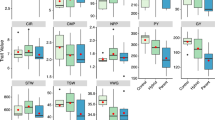Abstract
The degree of heterosis as expressed in respect of grain yield and eight other related quantitative traits (length and diameter of peduncle, surface area of primary ear, density of grain, yield of primary ear, plant height, tillering capacity and yield of straw) as compared to the value of mid-parent, the higher parent of the cross and the best of the lot studied was estimated for all the hybrids of a ten-parent pearl millet diallel cross. The percentage frequency of hybrids with significant heterosis was calculated for all the characters. Parents capable of producing highly heterotic hybrids were marked out.
The four parents which were outstanding in their ability to produce highly heterotic hybrids belong to different geographical regions. Only the vegetative characters,viz., length of peduncle, plant height and yield of straw exhibited marked reciprocal differences.
Similar content being viewed by others
References
Griffing, B... “Concept of general and specific combining ability in relation to diallel crossing systems,”Austr. J. biol. Sci., 1956,9, 463–93.
Hagberg, A... “Heterosis in F1 combinations inGaleopsis—I,”Hereditas, 1952a,38, 33–82.
—————.. “Heterosis in F1 combinations inGaleopsis—II,” Ibid., 1952b,38, 221–45.
Mahadevappa, M. and Ponnaiya, B. W. X. “Discriminant functions in the selection of pearl millet (Pennisetum typhoides Stapf and Hubb.) populations for grain yield,”Madras agric. J., 1967,54, 211–22.
Müntzing, A... “Hybrid vigour in crosses between pure lines ofGaleopsis tetrahit,”Hereditas, Lund., 1945,31, 391–98.
—————.. “Genetics in relation to plant breeding,”Proc. Ind. Acad. Sci., 1954,34, 227–41.
Pal, B. P... “Studies in hybrid vigour. I. Notes on the manifestation of hybrid vigour in gram, Sesamum, chilli and maize,”Indian J. Genet., 1945,5, 106–26.
—— and Singh, H... “Studies in hybrid vigour. II. Notes on the manifestation of hybrid vigour in the brinjal and bitter gourd,” Ibid., 1946,6, 19–33.
Patel, M. S... “Agronomic character study in reciprocal tobacco hybrids,” (Unpublished thesis, N. C. State College, Raleigh, 1948).
Santhanam, V... “Studies on heterosis in cotton,” (Unpublished thesis for M.Sc. Degree, Madras University, India, 1951).
Whaley, W. G. .. “Physiology of gene action in hybrids,”Heterosis, 1952, Iowa State College Press.
Williams, W. and Gilbert, N. “Heterosis and the inheritance of yield in the tomato,”Heredity, 1960,15, 133–50.
Author information
Authors and Affiliations
Additional information
Communicated by Prof. T. S. Sadasivan,f.a.sc.
A part of the Ph.D. Thesis, University of Madras, India (October, 1965). Work done at The Agricultural College and Research Institute, Coimbatore, India.
Rights and permissions
About this article
Cite this article
Mahadevappa, M. Studies on heterosis in pearl millet (Pennisetum typhoides stapf and Hubb.). Proc. Indian Acad. Sci. 67, 180–186 (1968). https://doi.org/10.1007/BF03053870
Received:
Issue Date:
DOI: https://doi.org/10.1007/BF03053870



